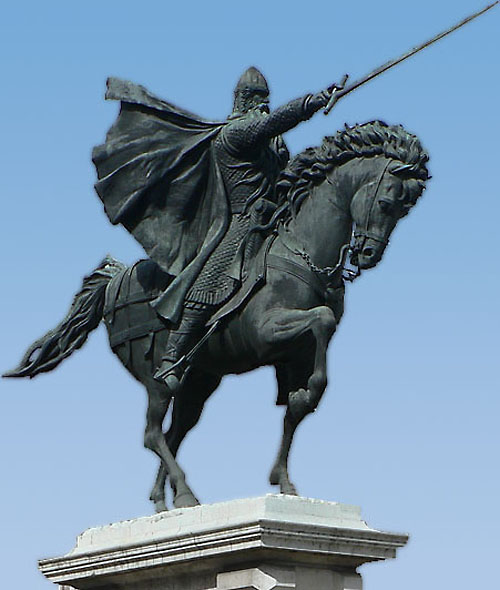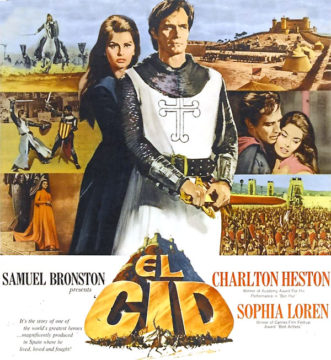by Thomas O’Dwyer

¡Buen Dios! Is it already 60 years since they filmed The Cid? A couple of weeks ago, I caught it again on Amazon Prime. All I remembered of first seeing it decades ago was the white-clad Cid thundering along Valencia beach, riding through the gates of history and into eternity, propped up dead on his beloved warhorse Babieca. Like a visit to a childhood home, the image proved to be grander in memory than in the rediscovered reality. Most of us ageing romantics prefer dreamy time-fixed images to duller realities. However, Anthony Mann’s cliche-soaked Tinseltown love story squeezed into medieval costume had first set me reflecting on the relationship between the visual and the verbal in our engagement with literature.
The noble Cid leading his warriors to battle even in death stuck at once in my mind as typical of elusive long-dead virtues I had been struggling to understand in the Greek and Latin texts pounded into our unwilling secondary-school heads. He had the virtutas of Aeneas, the arete of Achilles. I had seen the film of the Cid long before I came across The Poem of the Cid, translated from its 12th century Spanish and, though the two had little in common, the images I carried from the film lent some familiarity to the ancient tale. Likewise, I had less trouble with Virgil’s Aeneid because I had absorbed powerful images of the epic from, believe it or not, an English comic book. The weekly Eagle used to run stories from the classics in garish comic strips across its back page. It featured a vividly illustrated White Eagles Over Serbia, by Lawrence Durrell, for instance. I never got around to reading that book, but later read everything else Durrell wrote.
Mannings’s El Cid is not a bad movie from that era, a straightforward, old-fashioned medieval European epic. Rodrigo Diaz Vivar, El Cid, (from the Arabic al-Sayed, lord) remains a Spanish national hero. The medieval warrior was born in Burgos and died in Valencia in 1099. Following a Moorish invasion of Spain commanded by Emir Ben Yusuf, Cid led Castilian troops opposing the invader. Cid was married to Jimena, the devoted love of his life. He and Jimena had been living peacefully in Valencia for five years when the Moors besieged the city. According to legend, El Cid was fighting and shot in the heart with an arrow. Valencia’s troops were on the verge of collapse when Jimena raised and secured her husband’s body on his warhorse Babieca, who then led the inspired fighters out of the city to smash the besieging Moors and kill Ben Yusuf.
The cinematography is excellent, the scenery magnificent, the sets massive, and, of course, there is a cast of thousands. Seeing the film again conjured up some long-forgotten words like Cinemascope, Technicolour, and Hollywood epic, and barely remembered American blockbusters — Quo Vadis, Lawrence of Arabia, The Ten Commandments, Ben-Hur. The connection between cinematic or comic book images and the original words on which they were based was clear enough, and it was good, an illustrated pathway to more serious experiences. The words in the scripts of the film or the comic were another matter. In El Cid, Charlton Heston had the lead role and Sophia Loren the female lead as Jimena. The movie-set gossip was that Loren disliked Heston and the lack of chemistry between the characters on screen seemed to bear that out. The clunky dialogue didn’t help:
El Cid: I tried not to come. I tried, I told my love it had no right to live. But my love won’t die.
Jimena: Kill it.
El Cid: You kill it! Tell me you don’t love me.
Jimena: I cannot. Not yet. But I will make myself worthy of you Rodrigo, I will learn to hate you.
That should be easy; she will learn to hate listening to this drivel ere long.
There is much modern moaning about the trivialization of our children’s imaginations by television and other screens. The lazy absorption of packaged plots and images is cauterizing young brain cells that should be snapping and crackling in a struggle with the written words of their native languages. Books will soon be dead, buried beside attention spans, the thesis goes. Long live the virtual-reality cloud. This threat of looming illiteracy is unconvincing. Classic and historical literature has trickled into popular culture everywhere. There’s no reason why young people can’t trace the threads back to their original rich tapestry at some time in their cultural lives. El Cid even turns up in video games — In Medieval: Total War, El Cid is a general in the castle of Valencia. In the second Age of Empires game, The Conquerors, there is a campaign starring El Cid.
The threat of screens wasn’t an issue that ever concerned me. In the rural Irish home of my childhood, there were few books and no television. Forget the literary Irish. As a stereotype of a nation with a mysterious gift for words, it’s as corny as musical Germany or artistic Italy. One scarcely expects a Bavarian barmaid to dash off a sonata or an Italian beach-lizard to prefer drawing a bottom to pinching one. Neither was ours a village of poets. “I read a book once,” Buckley the milkman remarked, as I sat in the morning sunshine under a red-berried Rowan tree, nursing a broken 12-year-old shoulder and reading. “At least I think it was a book,” he added.
Twelve was the youngest age at which one could join the library in the nearby town, and I was there the first morning after the eleventh year had passed. Years later, I puzzled over my choice of three of the first four books I was allowed to check out and strap to the back of my bike. (The books and I arrived home sans bike, in an ambulance, but the broken shoulder is an uninteresting story). The three odd books were The Last Summer by Boris Pasternak, Analytical Chemistry, and Understanding Opera (authors long-forgotten). Given that strange lot, there was no mystery about the fourth choice — How To Read A Book, author also forgotten but unmasked by Goggle as Mortimer J. Adler. What I did remember was that was one of the most incomprehensible tomes I had ever failed to read.
In another library, 24 years later and 2,000 kilometres away, I picked up The Poem of the Cid and returned, like Lawrence Durrell in Justine, “link by link along the iron chain of memory” and understood the impact of images on awakening literary curiosity. Distant images, now insubstantial pageants fading, had moved the 12-year-old from trying to read words under a long-dead tree to now scratching a living scribbling them himself. In the weeks preceding that first trip to the library, I had acquired mental images of a few things I had never seen before — a first and second film, and a train. The films, projected in a bleak community centre by a wandering entrepreneur, were a sentimental light opera called The Song of Donegal and some low-budget Frankenstein. It is impossible to describe the explosive impact of test tubes, retorts, coils — the paraphernalia of science — on a primitive child whose home had not even electricity for his first ten years. Never mind the magical clacking projector, flickering screen. Donegal was a sung drama with a clear beginning, tense middle and a happy end. There was another life somewhere out there and in other places. The steam train I spotted with startling suddenness during a trip in an uncle’s battered car, streaking with rhythmic certainty through miles of bogland bulrushes to a vanishing point at the edge of the world.
One could trace a journey back through millions of words devoured and forgotten and to the first images. From a local Irish train to the haunting whistle over the Russian steppes in Pasternak’s idyllic Last Summer before World War I, and in The Adolescence of Zhenya Luvers. From one train to many trains; from Pasternak to more Pasternak and more Russians, writers, poets, and nations. From understanding opera and science and “how to read a book” to a life of mild frustration at not understanding everything. And finally, to a destination of understanding nothing, but taking pleasure just in the trying.

And bang, now and then, it’s back again — an image that started many pleasurable but mostly fruitless journeys. It is riding onwards in mockery at the head of its ghostly army — the Cid, the train, the mad scientist, the squeaky opera singer, Odysseus in an Eagle comic strip. I have read the Poem of the Cid many times since, and it resembles neither my first memory of it nor Hollywood’s. The ancient narrative creates its images by repeated stock phrases in the oral storytelling tradition. “The blood dripped down to his elbow” when killing Moors; “born at a fortunate time” for ravaging cities, and repeatedly, “The Cid captured immense booty.” Virtutas? Arete? And nowhere, but nowhere, does this booty-obsessed outlaw don a white shroud and thunder into victory and legend. The poem instead concludes with some rather squalid duels and arrangements aimed at getting his daughters first into and then out of marriages with two wretches known as the Infantes of Carrion. (Now there’s an image).
So the Cid that led me into the classics I cannot find in the real 12th-century narrative. And the train that took me into Pasternak, and the· novelists and poets, was on a 50-km provincial run to a place called Farnaleen, population 80 farmers. I have sat through Magic Flutes and La Boehemes, thanks to The Song of Donegal — may God preserve me from ever seeing it again. The medieval philosopher Thomas Aquinas abandoned his immense and astonishing labours in the vineyards of intellect with a dismissive “all I have written is straw.” Perhaps all we have read is rubbish.
No wonder writers and painters have so often preferred each other’s company to their artistic kin. Each has one half of a mystery. How can you create an image but can’t explain it to me? No, how do words you write evoke images of things I’ve never seen? Which came first, the image or the description of it? Or the Hollywood director’s botched attempts to reconstruct both?
In that inspiring final movie scene of the dead Cid and his warriors charging down the beach at Valencia and scattering the Moorish army, it’s worth taking a closer look. The tire tracks from the camera truck are visible in the sand. Yes, that magnificent sequence of El Cid strapped to his horse Babieca is compelling and moving. Never mind that car fleetingly captured in the background.
